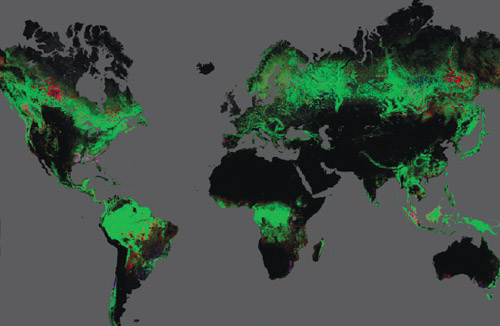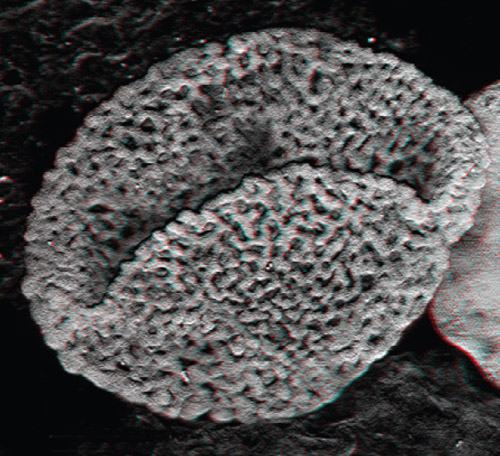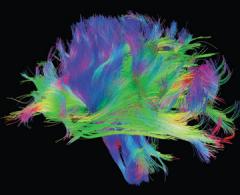
This Article From Issue
January-February 2014
Volume 102, Number 1
Page 9
DOI: 10.1511/2014.106.9
In this roundup, Katie Burke summarizes notable recent items about scientific research, selected from news reports compiled in the free electronic newsletter Sigma Xi SmartBrief. Online: https://www.smartbrief.com/sigmaxi/index.jsp
Global Map of Forest Changes
A publicly available, high-resolution map of forest cover—created by researchers at the University of Maryland, working with the Google Earth Engine—provides a powerful tool for forest researchers and environmental policy makers. The project was possible because the Landsat program opened its database of satellite imagery five years ago. The Maryland team knit together 654,178 Landsat images to show all the world’s forests at a resolution of just 30 meters; it covers the period from 1999 to 2012 and will be updated annually going forward. The map’s fine detail, combined with its broad spatial and temporal scope, will support local monitoring, regional comparisons of forest changes, and global measures of total forestation. By using Google Earth’s cloud computing resources, the researchers were able to complete their data processing, which would have taken 15 years on a single computer, in days.

M. C., Hansen, et al.
Hansen, M. C., et al. High-resolution global maps of 21st-century forest cover change. Science 342:850 (November 15)
Smart Material Has Memory
A new metal crystal, composed of zinc, gold, and copper, can efficiently switch back and forth between different arrangements of atoms depending on its temperature. It belongs to a family of smart materials called martensites. These materials are able to “remember” their previous shape and return to it after they are deformed, but previously developed versions accrued stresses during their shape changes and eventually degraded. A team from the University of Minnesota, Minneapolis, came up with the improved martensite, which is much more resilient. They cite a wide variety of potential applications, including efficient batteries, solar panels that change angle with the Sun’s arc, and quieter jet engines.
Song, Y., X. Chen, V. Dabade, T. W. Shield, and R. D. James. Enhanced reversibility and unusual microstructure of a phase-transforming material. Nature 502:85 (October 3)
New Theory of Higgsogenesis
The discovery of the Higgs boson has inspired a new theory, called Higgsogenesis, that could account for both the existence of dark matter and the extreme rarity of antimatter. The Standard Model of physics predicts that every particle has an antiparticle, and the Higgs is no exception. According to Higgsogenesis, an asymmetry between the Higgs boson and its antiparticle could have triggered a corresponding asymmetry between matter and antimatter, explaining why matter dominates the universe. The Higgs boson could also link with dark matter, accounting for its observed abundance. Higgsogenesis predicts the existence of an undiscovered particle associated with those connections. When the Large Hadron Collider restarts in 2015 it could search for such particles by looking for missing energy when Higgs bosons decay.
Servant, G., and S. Tulin. Baryogenesis and dark matter through a Higgs asymmetry. Physical Review Letters 111:151601 (October 11)
Flowering Plants Arose Earlier
The earliest fossil traces of flowering plants were discovered in northern Switzerland—in strata 100 million years older than the time when such plants were long thought to have evolved. Six distinct pollen grain types were identified in sediment dated to the middle Triassic period, 245 million years ago. Previously, the earliest known flowering plant pollen grains were from the Early Cretaceous, around 150 million years back. The huge gap between those two sets of evidence leaves many questions about what happened in between. Further, the number of pollen types in the Swiss sample suggests that flowering plants were already rather diverse, implying they must have arisen even earlier. In terms of abundance, number of species, and extent, flowering plants are the most successful of all plants. No biologist yet understands how their phenomenal radiation took place.

University of Zurich
Hochuli, P. A., and S. Feist-Burkhardt. Angiosperm-like pollen and Afropollis from the Middle Triassic (Anisian) of the Germanic Basin (Northern Switzerland). Frontiers in Plant Science 4:1 (October 1)
Infertile Woman Gives Birth
A novel procedure allowed a 29-year-old woman to naturally conceive a baby boy, even though she had a fertility disorder that previously would have left her with egg donation as her only option. Approximately 1 percent of women of reproductive age share this disorder, called premature ovarian failure, in which eggs do not mature properly because of a faulty cell-signaling pathway. To treat it, a medical research team removed the ovaries of 27 test subjects and stimulated follicle growth in the lab; they then reattached the ovarian tissue to the patients’ Fallopian tubes. Once an egg had matured, it was retrieved for in vitro fertilization. The new technique, called in vitro activation, produced follicle growth in 13 of the women, and mature eggs were retrieved from 5 of them. In addition to the one who already gave birth, another one of those five women is now pregnant. Millions of others could potentially benefit from the new treatment, but the researchers were criticized in the journal Nature for “clumsy” techniques and for rushing in vitro activation to human trials.

Kazuhiro Kawamura
Kawamura, K., et al. Hippo signaling disruption and Akt stimulation of ovarian follicles for infertility treatment. Proceedings of the National Academy of Sciences of the U.S.A. 110:17474 (October 22)

American Scientist Comments and Discussion
To discuss our articles or comment on them, please share them and tag American Scientist on social media platforms. Here are links to our profiles on Twitter, Facebook, and LinkedIn.
If we re-share your post, we will moderate comments/discussion following our comments policy.